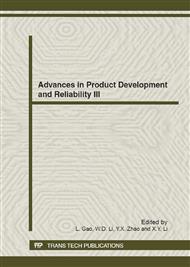p.139
p.145
p.151
p.159
p.164
p.170
p.176
p.182
p.188
Analytical Target Cascading Based on the Quadratic Exterior Penalty Method for Complex System Design
Abstract:
Analytical Target Cascading (ATC) is a method to partition the optimization of a complex system into a set of subsystem optimizations and a single system optimization according to the structure of the complex system, and coordinate subproblems toward an optimal system design. The constructed new optimization problem owns a hierarchical structure, which better matches the real organization structure of complex system design, so the ATC method provides a promising way to deal with the complex system. For each design problem at a given level, an optimization problem is to minimize the discrepancy between its responses and propagated targets. In ATC, for feasibility of subproblems, the target-response pairs are translated into the relaxation terms in which the weight coefficients is used to represent the relative importance of responses and linking variables matching their corresponding target, and achieve acceptable levels of inconsistency between subproblems when top level targets are unattainable in the hierarchical decomposition structure. Furthermore, weighting coefficients influence convergence efficiency and computational efficiency so that the suitable allocation of weight coefficients is a challenge. This paper adopts the Quadratic Exterior Penalty Method to deal with the weight coefficients that achieve solutions within user-specified acceptable inconsistency tolerances. Meanwhile, the method prototype will be tested on a numerical example and implemented using MATLAB and iSIGHT.
Info:
Periodical:
Pages:
164-169
Citation:
Online since:
June 2012
Authors:
Price:
Сopyright:
© 2012 Trans Tech Publications Ltd. All Rights Reserved
Share:
Citation:


